Problem 6.1: Signals on Transmission Lines
A modulated signal needs to be sent over a transmission line having a characteristic impedance of Z0 = 50 (Ω) . So that the signal does not interfere with signals others may be transmitting, it must be bandpass filtered so that its bandwidth is 1 MHz and centered at 3.5 MHz. The filter's gain should be one in magnitude. An op-amp filter (Figure 6.31) is proposed.
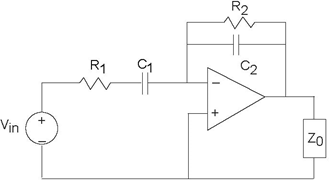
- What is the transfer function between the input voltage and the voltage across the transmission line?
- Find values for the resistors and capacitors so that design goals are met.
Problem 6.2: Noise in AM Systems
The signal  emerging from an AM communication system consists of
two parts: the message signal, s (t), and additive noise. The plot (Figure 6.32) shows the message spectrum S (f) and noise power spectrum PN (f) . The noise power spectrum lies completely within the
signal's band, and has a constant value there of
emerging from an AM communication system consists of
two parts: the message signal, s (t), and additive noise. The plot (Figure 6.32) shows the message spectrum S (f) and noise power spectrum PN (f) . The noise power spectrum lies completely within the
signal's band, and has a constant value there of 

- What is the message signal's power? What is the signal-to-noise ratio?
- Because the power in the message decreases with frequency, the signal-to-noise ratio is not constant within subbands. What is the signal-to-noise ratio in the upper half of the frequency band?
- A clever 241 student suggests filtering the message before the transmitter modulates it so that the signal spectrum is balanced (constant) across frequency. Realizing that this filtering affects the message signal, the student realizes that the receiver must also compensate for the message to arrive intact. Draw a block diagram of this communication system. How does this system's signal-to-noise ratio compare with that of the usual AM radio?
Problem 6.3: Complementary Filters
Complementary filters usually have "opposite" filtering characteristics (like a lowpass and a highpass) and have transfer functions that add to one. Mathematically, H1(f) and H2(f) are complementary if
H1(f)+ H2(f)=1
We can use complementary filters to separate a signal into two parts by passing it through each filter. Each output can then be transmitted separately and the original signal reconstructed at
the receiver. Let's assume the message is bandlimited to W Hz and that 
- What circuits would be used to produce the complementary filters?
- Sketch a block diagram for a communication system (transmitter and receiver) that employs complementary signal transmission to send a message m (t).
- What is the receiver's signal-to-noise ratio? How does it compare to the standard system that sends the signal by simple amplitude modulation?
Problem 6.4: Phase Modulation
A message signal m (t) phase modulates a carrier if the transmitted signal equals

where ϕd is known as the phase deviation. In this problem, the phase deviation is small. As with all analog modulation schemes, assume that |m (t) | < 1, the message is bandlimited to W Hz, and the carrier frequency fc is much larger than W .
- What is the transmission bandwidth?
- Find a receiver for this modulation scheme.
- What is the signal-to-noise ratio of the received signal?
HINT: Use the facts that  for small x.
for small x.
Problem 6.5: Digital Amplitude Modulation
Two ELEC 241 students disagree about a homework problem. The issue concerns the discrete-time signal s(n) cos(2πf0n) , where the signal s(n) has no special characteristics and the modulation frequency f0 is known. Sammy says that he can recover s(n) from its amplitude-modulated version by the same approach used in analog communications. Samantha says that approach won't work.
- What is the spectrum of the modulated signal?
- Who is correct? Why?
- The teaching assistant does not want to take sides. He tells them that if s(n) cos(2πf0n) and s(n) sin(2πf0n)were both available, s(n) can be recovered. What does he have in mind?
Problem 6.6: Anti-Jamming
One way for someone to keep people from receiving an AM transmission is to transmit noise at the same carrier frequency. Thus, if the carrier frequency is fc so
that the transmitted signal is  the jammer would transmit
the jammer would transmit  The noise
n(t) has a constant power density spectrum over the bandwidth of the message m(t). The channel adds white noise of spectral height
The noise
n(t) has a constant power density spectrum over the bandwidth of the message m(t). The channel adds white noise of spectral height
a) What would be the output of a traditional AM receiver tuned to the carrier frequency fc?
b) RU Electronics proposes to counteract jamming by using a different modulation scheme. The scheme's transmitted signal has the form

where c(t) is a periodic carrier signal (period  ) having
the indicated waveform (Figure 6.33). What is the spectrum of the
transmitted signal with the proposed scheme? Assume the message bandwidth W is much less than the fundamental carrier frequency fc.
) having
the indicated waveform (Figure 6.33). What is the spectrum of the
transmitted signal with the proposed scheme? Assume the message bandwidth W is much less than the fundamental carrier frequency fc.
c) The jammer, unaware of the change, is transmitting with a carrier frequency of fc, while the receiver tunes a standard AM receiver to a harmonic of the carrier frequency. What is the signal-to-noise ratio of the receiver tuned to the harmonic having the largest power that does not contain the jammer?
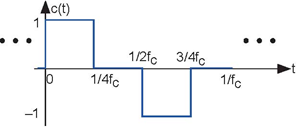
Problem 6.7: Secret Communications
A system for hiding AM transmissions has the transmitter randomly switching between two carrier frequencies f1 and f2. "Random switching" means that one carrier frequency is used
for some period of time, switches to the other for some other period of time, back to the first, etc. The receiver knows what the carrier frequencies are but not when carrier frequency switches
occur. Consequently, the receiver must be designed to receive the transmissions regardless of which carrier frequency is used. Assume the message signal has bandwidth W. The channel
adds white noise of spectral height 
- How different should the carrier frequencies be so that the message could be received?
- What receiver would you design?
- What signal-to-noise ratio for the demodulated signal does your receiver yield?
Problem 6.8: AM Stereo
Stereophonic radio transmits two signals simultaneously that correspond to what comes out of the left and right speakers of the receiving radio. While FM stereo is commonplace, AM stereo is not, but is much simpler to understand and analyze. An amazing aspect of AM stereo is that both signals are transmitted within the same bandwidth as used to transmit just one. Assume the left and right signals are bandlimited to W Hz.
x (t)= A (1 + ml (t)) cos (2πfct)+ Amr (t) sin (2πfct)
- Find the Fourier transform of x(t). What is the transmission bandwidth and how does it compare with that of standard AM?
- Let us use a coherent demodulator as the receiver, shown in Figure 6.34. Show that this receiver indeed works: It produces the left and right signals separately.
- Assume the channel adds white noise to the transmitted signal. Find the signal-to-noise ratio of each signal.
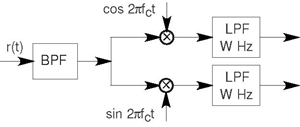
Problem 6.9: A Novel Communication System
A clever system designer claims that the depicted transmitter (Figure
6.35) has, despite its complexity, advantages over the usual amplitude modulation system. The message signal m(t) is bandlimited to W Hz, and the carrier frequency
fc» W . The channel attenuates the transmitted signal x(t) and adds white noise of spectral height 
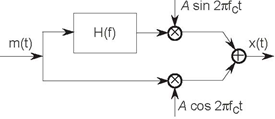
The transfer function H(f) is given by 
- Find an expression for the spectrum of x(t). Sketch your answer.
- Show that the usual coherent receiver demodulates this signal.
- Find the signal-to-noise ratio that results when this receiver is used.
- Find a superior receiver (one that yields a better signal-to-noise ratio), and analyze its performance.
Problem 6.10: Multi-Tone Digital Communication
In a so-called multi-tone system, several bits are gathered together and transmitted simultaneously on different carrier frequencies during a T second interval. For example, B bits would be transmitted according to

(6.61)
Here, f0 is the frequency offset for each bit and it is harmonically related to the bit interval T. The value of bk is either −1 or +1.
- Find a receiver for this transmission scheme.
- An ELEC 241 almuni likes digital systems so much that he decides to produce a discrete-time version. He samples the received signal
 How should N be related to
B, the number of simultaneously transmitted bits?
How should N be related to
B, the number of simultaneously transmitted bits?
- The alumni wants to find a simple form for the receiver so that his software implementation runs as efficiently as possible. How would you recommend he implement the receiver?
Problem 6.11: City Radio Channels
In addition to additive white noise, metropolitan cellular radio channels also contain multipath: the attenuated signal and a delayed, further attenuated signal are received superimposed. As shown in Figure 6.36, multipath occurs because the buildings reflect the signal and the reflected path length between transmitter and receiver is longer than the direct path.
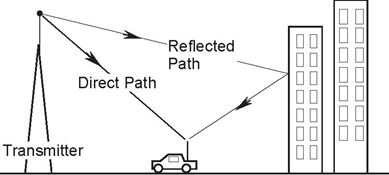
Assume that the length of the direct path is d meters and the reflected path is 1.5 times as long. What is the model for the channel, including the multipath and the additive noise?
Assume d is 1 km. Find and sketch the magnitude of the transfer function for the multipath component of the channel. How would you characterize this transfer function?
Would the multipath affect AM radio? If not, why not; if so, how so? Would analog cellular telephone, which operates at much higher carrier frequencies (800 MHz vs. 1 MHz for radio), be affected or not? Analog cellular telephone uses amplitude modulation to transmit voice.
How would the usual AM receiver be modified to minimize multipath effects? Express your modified receiver as a block diagram.
Problem 6.12: Downlink Signal Sets
In digital cellular telephone systems, the base station (transmitter) needs to relay different voice signals to several telephones at the same time. Rather than send signals at different frequencies, a clever Rice engineer suggests using a different signal set for each data stream. For example, for two simultaneous data streams, she suggests BPSK signal sets that have the depicted basic signals (Figure 6.37).

Thus, bits are represented in data stream 1 by s1(t) and −s1(t) and in data stream 2 by s2(t) and −s2(t), each of which are modulated by 900 MHz carrier. The transmitter sends the two data streams so that their bit intervals align. Each receiver uses a matched filter for its receiver. The requirement is that each receiver not receive the other's bit stream.
- What is the block diagram describing the proposed system?
- What is the transmission bandwidth required by the proposed system?
- Will the proposal work? Does the fact that the two data streams are transmitted in the same bandwidth at the same time mean that each receiver's performance is affected? Can each bit stream be received without interference from the other?
Problem 6.13: Mixed Analog and Digital Transmission
A signal m(t) is transmitted using amplitude modulation in the usual way. The signal has bandwidth W Hz, and the carrier frequency is fc. In addition to sending this analog signal, the transmitter also wants to send ASCII text in an auxiliary band that lies slightly above the analog transmission band. Using an 8-bit representation of the characters and a simple baseband BPSK signal set (the constant signal +1 corresponds to a 0, the constant -1 to a 1), the data signal d(t) representing the text is transmitted as the same time as the analog signal m(t). The transmission signal spectrum is as shown (Figure 6.38), and has a total bandwidth B.
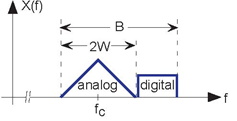
- Write an expression for the time-domain version of the transmitted signal in terms of m(t) and the digital signal d(t).
- What is the maximum datarate the scheme can provide in terms of the available bandwidth?
- Find a receiver that yields both the analog signal and the bit stream.
Problem 6.14: Digital Stereo
Just as with analog communication, it should be possible to send two signals simultaneously over a digital channel. Assume you have two CD-quality signals (each sampled at 44.1 kHz with 16 bits/sample). One suggested transmission scheme is to use a quadrature BPSK scheme. If b(1) (n) and b(2) (n) each represent a bit stream, the transmitted signal has the form

where p(t) is a unit-amplitude pulse having duration T and b(1) (n), b(2) (n) equal either +1 or -1 according to the bit being transmitted for each signal. The channel adds white noise and attenuates the transmitted signal.
- What value would you choose for the carrier frequency fc?
- What is the transmission bandwidth?
- What receiver would you design that would yield both bit streams?
Problem 6.15: Digital and Analog Speech Communication
Suppose we transmit speech signals over comparable digital and analog channels. We want to compare the resulting quality of the received signals. Assume the transmitters use the same power, and the channels introduce the same attenuation and additive white noise. Assume the speech signal has a 4 kHz bandwidth and, in the digital case, is sampled at an 8 kHz rate with eight-bit A/D conversion. Assume simple binary source coding and a modulated BPSK transmission scheme.
- What is the transmission bandwidth of the analog (AM) and digital schemes?
- Assume the speech signal's amplitude has a magnitude less than one. What is maximum amplitude quantization error introduced by the A/D converter?
- In the digital case, each bit in quantized speech sample is received in error with probability pe that depends on signal-to-noise ratio
 However, errors in each bit have a different impact on the error in N0 the
reconstructed speech sample. Find the mean-squared error between the transmitted and received amplitude.
However, errors in each bit have a different impact on the error in N0 the
reconstructed speech sample. Find the mean-squared error between the transmitted and received amplitude.
- In the digital case, the recovered speech signal can be considered to have two noise sources added to each sample's true value: One is the A/D amplitude quantization noise and the second is due to channel errors. Because these are separate, the total noise power equals the sum of these two. What is the signal-to-noise ratio of the received speech signal as a function of pe?
- Compute and plot the received signal's signal-to-noise ratio for the two transmission schemes as a function of channel signal-to-noise ratio.
- Compare and evaluate these systems.
Problem 6.16: Source Compression
Consider the following 5-letter source.
|
Letter |
Probability |
|
a |
0.5 |
|
b |
0.25 |
|
c |
0.125 |
|
d |
0.0625 |
|
e |
0.0625 |
- Find this source's entropy.
- Show that the simple binary coding is inefcient.
- Find an unequal-length codebook for this sequence that satisfes the Source Coding Theorem. Does your code achieve the entropy limit?
- How much more efcient is this code than the simple binary code?
Problem 6.17: Source Compression
Consider the following 5-letter source.
|
Letter |
Probability |
|
a |
0.4 |
|
b |
0.2 |
|
c |
0.15 |
|
d |
0.15 |
|
e |
0.1 |
- Find this source's entropy.
- Show that the simple binary coding is inefficient.
- Find the Huffman code for this source. What is its average code length?
Problem 6.18: Speech Compression
When we sample a signal, such as speech, we quantize the signal's amplitude to a set of integers. For a b-bit converter, signal amplitudes are represented by 2b integers. Although these integers could be represented by a binary code for digital transmission, we should consider whether a Huffman coding would be more efficient.
- Load into Matlab the segment of speech contained in y.mat. Its sampled values lie in the interval (-1, 1). To simulate a 3-bit converter, we use Matlab's
round function to create quantized amplitudes corresponding to the integers [0l23456 7J.
- y quant = round(3.5*y + 3.5); Find the relative frequency of occurrence of quantized amplitude values. The following Matlab program computes the number of times each quantized value occurs.
- for n=0:7; count(n+l) = sum(y quant == n); end; Find the entropy of this source.
- Find the Hufman code for this source. How would you characterize this source code in words?
- How many fewer bits would be used in transmitting this speech segment with your Hufman code in comparison to simple binary coding?
Problem 6.19: Digital Communication
In a digital cellular system, a signal bandlimited to 5 kHz is sampled with a two-bit A/D converter at its Nyquist frequency. The sample values are found to have the shown relative frequencies.
|
Sample Value |
Probability |
|
0 |
0.15 |
|
1 |
0.35 |
|
2 |
0.3 |
|
3 |
0.2 |
We send the bit stream consisting of Hufman-coded samples using one of the two depicted signal sets (Figure 6.39).

- a) What is the datarate of the compressed source?
- b) Which choice of signal set maximizes the communication system's performance?
- c) With no error-correcting coding, what signal-to-noise ratio would be needed for your chosen signal set to guarantee that the bit error probability will not exceed 10−3? If the receiver moves twice as far from the transmitter (relative to the distance at which the 10−3 error rate was obtained), how does the performance change?
Problem 6.20: Signal Compression
Letters drawn from a four-symbol alphabet have the indicated probabilities.
|
Letter |
Probability |
|
a |
1/3 |
|
b |
1/3 |
|
c |
1/4 |
|
d |
1/12 |
Table 6.8
- What is the average number of bits necessary to represent this alphabet?
- Using a simple binary code for this alphabet, a two-bit block of data bits naturally emerges. Find an error correcting code for two-bit data blocks that corrects all single-bit errors.
- How would you modify your code so that the probability of the letter a being confused with the letter d is minimized? If so, what is your new code; if not, demonstrate that this goal cannot be achieved.
Problem 6.21: Universal Product Code
The Universal Product Code (UPC), often known as a bar code, labels virtually every sold good. An example (Figure 6.40) of a portion of the code is shown.
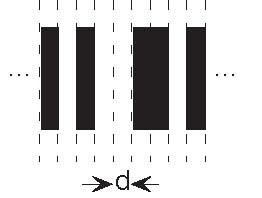
Here a sequence of black and white bars, each having width d, presents an 11-digit number (consisting of decimal digits) that uniquely identifes the product. In retail stores, laser scanners read this code, and after accessing a database of prices, enter the price into the cash register.
- How many bars must be used to represent a single digit?
- A complication of the laser scanning system is that the bar code must be read either forwards or backwards. Now how many bars are needed to represent each digit?
- What is the probability that the 11-digit code is read correctly if the probability of reading a single bit incorrectly is pe?
- How many error correcting bars would need to be present so that any single bar error occurring in the 11-digit code can be corrected?
Problem 6.22: Error Correcting Codes
A code maps pairs of information bits into codewords of length 5 as follows.
|
Data |
Codeword |
|
00 |
00000 |
|
01 |
01101 |
|
10 |
10111 |
|
11 |
11010 |
- What is this code's efficiency?
- Find the generator matrix G and parity-check matrix H for this code.
- Give the decoding table for this code. How many patterns of 1, 2, and 3 errors are correctly decoded?
- What is the block error probability (the probability of any number of errors occurring in the decoded codeword)?
Problem 6.23: Digital Communication
A digital source produces sequences of nine letters with the following probabilities.
| letter | a | b | c | d | e | f | g | h | i |
| probability |

|

|

|

|

|

|

|

|

|
| c1=d1 |

|
| c2=d2 |

|
| c3=d3 | c6=d1 |
What is the error correction capability of this code?
Problem 6.24: Overly Designed Error Correction Codes
An Aggie engineer wants not only to have codewords for his data, but also to hide the information from Rice engineers (no fear of the UT engineers). He decides to represent 3-bit data with 6-bit codewords in which none of the data bits appear explicitly.
|
c1 = d1 ⊕ d2 |
c4 = d1 ⊕ d2 ⊕ d3 |
|
c2 = d2 ⊕ d3 |
c5 = d1 ⊕ d2 |
|
c3 = d1 ⊕ d3 |
c6 = d1 ⊕ d2 ⊕ d3 |
- Find the generator matrix G and parity-check matrix H for this code.
- Find a 3 × 6 matrix that recovers the data bits from the codeword.
- What is the error correcting capability of the code?
Problem 6.25: Error Correction?
It is important to realize that when more transmission errors than can be corrected, error correction algorithms believe that a smaller number of errors have occurred and correct accordingly. For example, consider a (7,4) Hamming code having the generator matrix
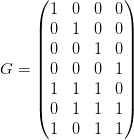
This code corrects all single-bit error, but if a double bit error occurs, it corrects using a single-bit error correction approach.
- How many double-bit errors can occur in a codeword?
- For each double-bit error pattern, what is the result of channel decoding? Express your result as a binary error sequence for the data bits.
Problem 6.26: Selective Error Correction
We have found that digital transmission errors occur with a probability that remains constant no matter how "important" the bit may be. For example, in transmitting digitized signals, errors occur as frequently for the most significant bit as they do for the least significant bit. Yet, the former errors have a much larger impact on the overall signal-to-noise ratio than the latter. Rather than applying error correction to each sample value, why not concentrate the error correction on the most important bits? Assume that we sample an 8 kHz signal with an 8-bit A/D converter. We use single-bit error correction on the most significant four bits and none on the least significant four. Bits are transmitted using a modulated BPSK signal set over an additive white noise channel.
- How many error correction bits must be added to provide single-bit error correction on the most significant bits?
- How large must the signal-to-noise ratio of the received signal be to insure reliable communication?
- Assume that once error correction is applied, only the least significant 4 bits can be received in error. How much would the output signal-to-noise ratio improve using this error correction scheme?
Problem 6.27: Compact Disk
Errors occur in reading audio compact disks. Very few errors are due to noise in the compact disk player; most occur because of dust and scratches on the disk surface. Because scratches span several bits, a single-bit error is rare; several consecutive bits in error are much more common. Assume that scratch and dust-induced errors are four or fewer consecutive bits long. The audio CD standard requires 16-bit, 44.1 kHz analog-to-digital conversion of each channel of the stereo analog signal.
- How many error-correction bits are required to correct scratch-induced errors for each 16-bit sample?
- Rather than use a code that can correct several errors in a codeword, a clever 241 engineer proposes interleaving consecutive coded samples. As the cartoon (Figure 6.41) shows, the bits representing coded samples are interpersed before they are written on the CD. The CD player de-interleaves the coded data, then performs error-correction. Now, evaluate this proposed scheme with respect to the non-interleaved one.

Problem 6.28: Communication System Design
RU Communication Systems has been asked to design a communication system that meets the following requirements.
- The baseband message signal has a bandwidth of 10 kHz.
- The RUCS engineers find that the entropy H of the sampled message signal depends on how many bits b are used in the A/D converter (see table below).
- The signal is to be sent through a noisy channel having a bandwidth of 25 kHz channel centered at 2 MHz and a signal-to-noise ration within that band of 10 dB.
- Once received, the message signal must have a signal-to-noise ratio of at least 20 dB.
|
b |
H |
|
3 |
2.19 |
|
4 |
3.25 |
|
5 |
4.28 |
|
6 |
5.35 |
Can these specifcations be met? Justify your answer.
Problem 6.29: HDTV
As HDTV (high-Definition television) was being developed, the FCC restricted this digital system to use in the same bandwidth (6 MHz) as its analog (AM) counterpart. HDTV video is sampled on a 1035 × 1840 raster at 30 images per second for each of the three colors. The least-acceptable picture received by television sets located at an analog station's broadcast perimeter has a signal-to-noise ratio of about 10 dB.
- Using signal-to-noise ratio as the criterion, how many bits per sample must be used to guarantee that a high-quality picture, which achieves a signal-to-noise ratio of 20 dB, can be received by any HDTV set within the same broadcast region?
- Assuming the digital television channel has the same characteristics as an analog one, how much compression must HDTV systems employ?
Problem 6.30: Digital Cellular Telephones
In designing a digital version of a wireless telephone, you must first consider certain fundamentals. First of all, the quality of the received signal, as measured by the signal-to-noise ratio, must be at least as good as that provided by wireline telephones (30 dB) and the message bandwidth must be the same as wireline telephone. The signal-to-noise ratio of the allocated wirelss channel, which has a 5 kHz bandwidth, measured 100 meters from the tower is 70 dB. The desired range for a cell is 1 km. Can a digital cellphone system be designed according to these criteria?
Problem 6.31: Optimal Ethernet Random Access Protocols
Assume a population of N computers want to transmit information on a random access channel. The access algorithm works as follows.
- Before transmitting, flip a coin that has probability p of coming up heads
- If only one of the N computer's coins comes up heads, its transmission occurs successfully, and the others must wait until that transmission is complete and then resume the algorithm.
- If none or more than one head comes up, the N computers will either remain silent (no heads) or a collision will occur (more than one head). This unsuccessful transmission situation will be detected by all computers once the signals have propagated the length of the cable, and the algorithm resumes (return to the beginning).
- What is the optimal probability to use for flipping the coin? In other words, what should p be to maximize the probability that exactly one computer transmits?
- What is the probability of one computer transmitting when this optimal value of p is used as the number of computers grows to infinity?
- Using this optimal probability, what is the average number of coin flips that will be necessary to resolve the access so that one computer successfully transmits?
- Evaluate this algorithm. Is it realistic? Is it efficient?
Problem 6.32: Repeaters
Because signals attenuate with distance from the transmitter, repeaters are frequently employed for both analog and digital communication. For example, let's assume that the transmitter and receiver are D m apart, and a repeater is positioned halfway between them (Figure 6.42). What the repeater does is amplify its received signal to exactly cancel the attenuation encountered along the first leg and to re-transmit the signal to the ultimate receiver. However, the signal the repeater receives contains white noise as well as the transmitted signal. The receiver experiences the same amount of white noise as the repeater.

- What is the block diagram for this system?
- For an amplitude-modulation communication system, what is the signal-to-noise ratio of the demodulated signal at the receiver? Is this better or worse than the signal-to-noise ratio when no repeater is present?
- For digital communication, we must consider the system's capacity. Is the capacity larger with the repeater system than without it? If so, when; if not, why not?
Problem 6.33: Designing a Speech Communication System
We want to examine both analog and digital communication alternatives for a dedicated speech transmission system. Assume the speech signal has a 5 kHz bandwidth. The wireless link between transmitter and receiver is such that 200 watts of power can be received at a pre-assigned carrier frequency. We have some latitude in choosing the transmission bandwidth, but the noise power added by the channel increases with bandwidth with a proportionality constant of 0.1 watt/kHz.
- Design an analog system for sending speech under this scenario. What is the received signal-to-noise ratio under these design constraints?
- How many bits must be used in the A/D converter to achieve the same signal-to-noise ratio?
- Is the bandwidth required by the digital channel to send the samples without error greater or smaller than the analog bandwidth?
Problem 6.34: Digital vs. Analog
You are the Chairman/Chairwoman of the FCC. The frequency band 3 MHz to 3.5 MHz has been allocated for a new "high-quality" AM band. Each station licensed for this band will transmit signals having a bandwidth of 10 kHz, twice the message bandwidth of what current stations can send.
- How many stations can be allocated to this band and with what carrier frequencies?
- Looking ahead, conversion to digital transmission is not far in the future. The characteristics of the new digital radio system need to be established and you are the boss! Detail the characteristics of the analog-to-digital converter that must be used to prevent aliasing and ensure a signal-to-noise ratio of 25 dB.
- Without employing compression, how many digital radio stations could be allocated to the band if each station used BPSK modulation? Evaluate this design approach.
- 瀏覽次數:5845






